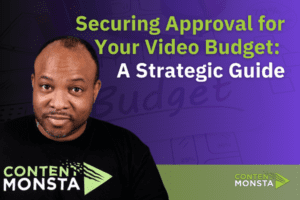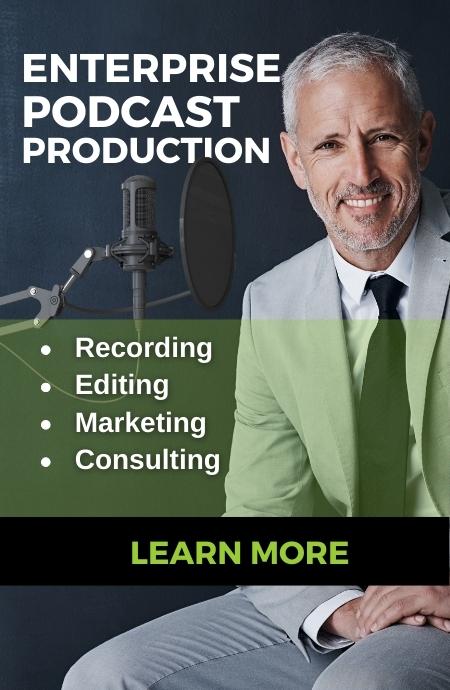Preparing thought leaders for video interviews is extremely necessary before placing them in front of a camera. We know that video is a great way of increasing the overall success of your video content marketing strategy, but only if the video that you capture relays the message and look that you expect. Whether coming from internal leaders or from outside voices like customers, video interviews will provide your audience with a different perspective of your company and industry.
You will not only be able to answer your audiences’ most pressing questions but also establish yourself as an industry leader in the process. From an SEO standpoint, Google loves websites that show Expertise, Authority, and Trust (E-A-T) and thought leadership videos are a strong step in this direction.
But before setting your executive, customer, or thought leader in front of a camera, you will need to make sure that both of you are fully prepared. Make sure to cover the following steps.
When Preparing Thought Leaders for Video Interviews [Table of Contents]
- Decide on the Message You Want to Deliver in the Video
- Select People Who Can Speak Freely on the Topic
- Prepare Questions in Advance
- Decide Who Will Be Asking the Questions in the Interview
- Share the Most Important Questions With the Interviewee in Advance
- Find out What Topics Are Off-Limits
- Get Confirmation on the Interviewee’s Calendar
- Give Your Interviewee a Dress Code
- Plan Adequate Time for the Interview
Decide on the Message You Want to Deliver in the Video
Video interviews are typically brief, meaning that there is a fairly limited time to deliver messages. To convey the context, you should pick only one to two messages that will resonate with the audience and support your marketing goals.
Both you and your guest should focus on how to package these message points so they can be reiterated several times during the interview. Keep in mind that you won’t use all of the video footage captured, so be prepared to approach the message from multiple angles during the interview.
When developing these messages, try thinking like a trial lawyer and provide your guests with proof points that they can back up with the assertions made. Whether you provide the talking points or work together on crafting the message, make sure to keep the message clear, credible, concise, defensible, and memorable.
Select People Who Can Speak Freely on the Topic
Even though you will need to prepare a script in advance, your interviewee should be someone capable of speaking freely on the topic without the need for one. This refers to someone well versed on the subject, preferably with a background and first-hand experience in the industry.
This way, you will avoid too many pauses, “umm” moments, and any awkward silences, which will have to be edited out later. Likewise, a knowledgeable person’s tone and demeanor will also have a greater impact on the audience and overall interview, further reinforcing the message.
When preparing a thought leader for video that is a customer, try to choose someone close to the project. Someone who was either a part of the decision to hire your company or someone with hands-on experience with your product or service.
If interviewing internally, don’t be afraid to choose people on the front line who have a hand in the product or service. They will have experiences and viewpoints that executives may not have. Plus they often provide a more convincing and credible voice to your customers who view the video interview.
Prepare Questions in Advance
While your video interview should have a loose conversation feel to it, this doesn’t mean that you should simply “wing it” and see what happens. Make sure that all talking points are laid out and that the discussion has a position to make.
Create questions based on things that you want your audience to know or understand better. These questions will act as the framework for the entire interview.
When preparing thought leaders for video be sure that the questions that you have planned are open-ended and give space for further remarks and conversation to start. You’ll often find your best gems (and facial expressions) when the speaker is able to recall information or a story on the spot when prompted by an open-ended question.
Decide Who Will Be Asking the Questions in the Interview
For the overall effectiveness of the video interview, the interviewer is almost as equally as important as the interviewee. It’s best that it is someone who works with the interviewee, as they will have better follow up questions. If the producer is asking the questions, it is even more important to have every single question documented and handed to the producer/interviewer as a written script. Also, make sure the interviewee knows in advance who will be asking the questions and how the interaction is expected to flow.
Share the Most Important Questions With the Interviewee in Advance
It’s not necessary to share all of your questions with the interviewee, but make sure that you have shared enough with them to cover your message and goals. Holding back on some questions will provide opportunities to capture more lively and less rehearsed responses.
Nevertheless, sharing the most difficult and important questions with the interviewee in advance is highly recommended. You will get feedback from them regarding these questions and whether these are easy conversation starting points. If they are not, it’s probably best to rethink these questions or reframe them from a different point of view.
Find out What Topics Are Off-Limits
You should also talk with your thought leader about any off-limits topics before the interview. You don’t want to accidentally stumble upon any controversial topics or ask about an unreleased product. There may also be some timely issues at hand such as competitive tension, legal issues, company PR events that need to be avoided. While these issues may be of some interest to your audience, your interviewee may not appreciate it very much.
Get Confirmation on the Interviewee’s Calendar
There’s a lot that goes into preparing a thought leader for video interview, aside from what we’ve discussed here. The last thing you would want is to prepare everything only to have your interviewee not attend for one reason or another. Not only will this screw up your plans, but you may also end up paying a camera crew that won’t record anything.
Therefore, you should make sure that your interviewee has confirmed the date and time of the interview so that everything can go as planned. Be sure to follow up with them regularly leading up to the shoot date. Any changes will need to be conveyed to your production company as soon as possible in order to avoid possible cancellation or rescheduling fees.
Give Your Interviewee a Dress Code
Here is where preparing your thought leader for video gets personal. While some of your guests may have been in front of a professional camera before, others may not. You should give them a dress code and prepare them for the camera.
Several key points need to be taken into consideration here. For starters, they should avoid bright colors and fine print patterns that may cause odd effects when filmed. This will keep the focus on them and not on their attire.
Another general rule is that they shouldn’t wear white in front of the camera. Men should unbutton their suit jacket when seated and button it when standing. When the lights are turned on, the studio can become quite warm. Mid-weight clothing is the best choice to prevent sweating.
Because a technician may need to clip a lavalier microphone onto clothing, having jackets or collars can be a plus. Large or noisy jewelry should be avoided as it may swing against the microphone or make noise that distracts from the speaker’s voice.
They should also opt for contact lenses instead of eyeglasses. If they do wear eyeglasses, non-reflective lenses are best since there will be bright lights pointed at them. Men should consider shaving close to airtime, while both men and women should apply a matte finish to avoid a shiny face. Blush and eye makeup should only be slightly heavier than usual.
Most of all, make sure that the dress style matches the image of the company that you want to portray. Tech companies may opt for the “startup t-shirt” look while financial companies may go full business formal.
Plan Adequate Time for the Interview
Even if you’ve prepared the interview down to the second, there are always unexpected circumstances that you should anticipate. As a general rule, it’s best to block at least 30 minutes more than you think you’ll need.
This will give you extra time to check the interviewee’s look and have a warm-up chat. You can also go over the topics you’d like to discuss and set the tone for the interview.
It is also a good idea to book an extra time slot in case someone has to reschedule within that day or there is a major shift in scheduling. Take into account any long answers that you don’t want to cut off during the post-production process. Always keep in mind that rushed interviews will not give the best results.
Conclusion
Preparing thought leaders for video interviews is your best bet for capturing the content you need on shoot day. There are many people involved from the interviewee, the interviewer, the production team, and even possibly the marketing team seeking to utilize the thought leadership content.
You can’t afford to put all of these people in motion without a plan and full preparation. Follow these steps and you can expect a smooth production day and the creation of effective thought leader content for marketing.
Do you want to know more about video interview best practices? Talk to a professional Content Monsta!
- The QvQ Content Funnel: Ending the Quality versus Quantity QuestionMarketers often debate whether to prioritize the quality or quantity of content. The QvQ Content Funnel proposes a strategy to balance both, tailoring content type and volume to different sales funnel stages. This method enhances engagement, drives conversions, and builds customer loyalty by delivering the right content at the right time.
- 5 Digital Marketing Content Types That Drive BusinessThere are several digital marketing content types that are sure to …
- Marketing Video Budget – How to secure executive approvalDiscover how to secure executive approval for your video marketing budget. This article teaches you to address the critical concerns of CFOs and CMOs, focusing on efficiency, cost-effectiveness, and ROI. Learn strategies for promoting quick turnarounds, diversifying video content, and implementing remote production. Equip yourself with the tools to present a strategic, results-oriented plan that aligns with your company’s goals and impresses your executives.









